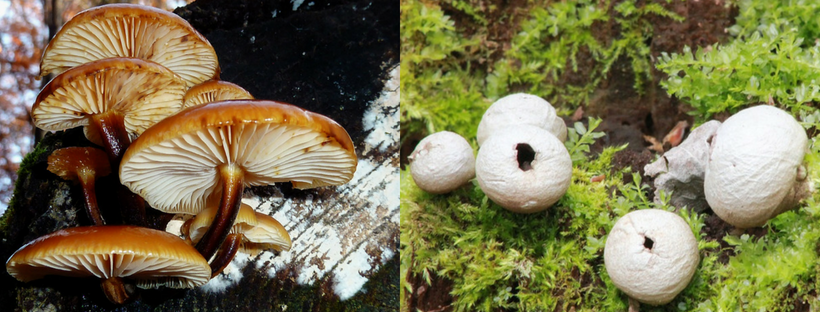When people think of the Great Ocean Road, they usually think of iconic coastal sights such as the Twelve Apostles and Loch Ard Gorge. What they probably don’t think of is fungus!
But right now, it’s fungus season! The forest floors in the region are exploding with fungi in all kinds of weird and wonderful colours and shapes.
Not all fungi are shaped like mushrooms though. While you will certainly see the typical toadstool variety, you also might see puffballs, coral-like fungi, globe shaped fungi, jelly-like fungi and fungi with spines, gills and crinkles.
The mushroom season runs roughly from April to June, although this does depend on the weather conditions. In general, wetter weather means more mushrooms. If you’re heading out into the nearby forests, make sure you wear warm layers and bring your waterproofs and good walking boots. We also suggest you bring a magnifying glass and a camera with you. These will help you to have a good look at all the textures and the edges of the gills and spines. In fact, the fungi on display at this time of year can be a photographer’s dream!
Please do remember that some fungi are poisonous so please don’t pick or eat any (unless you have an experienced mushroom forager with you), otherwise you could end up in hospital.
Alkina Lodge is close to the beautiful Otway Ranges which are a great place for fungi spotting. Our three luxury lodges are just perfect for a bit of rest, relaxation and indulgence when you get back at the end of the day. Click here to be taken to make a booking.
Fungus Facts
- Did you know that it is estimated that there are between 50,000 and 250,000 species of fungi in Australia?
- What you see sticking out of the ground or on the side of a log is probably the fruit-body, the part of the fungus that carries and spreads the spores needed for reproduction. All the rest of the fungus remains under the surface.
- Fungi are notoriously difficult to identify, as many species look very similar.
- Fungi that can be seen by the naked eye are known as macrofungi. There are also microfungi which can only be seen under a microscope.
- Fungi are an important source of unusual chemicals which are used in the medical industry to make antibiotics, statins and anti-cancer drugs.
Fungus Photography Tips
- Take shots from different angles: as close to the ground as possible (so you can see underneath), from above and from the side.
- Use a good lens and/or get close enough to completely fill your frame with the fungus and clearly see the detail.
- Sometimes it’s interesting to put something like a coin next to the fungus when you photograph it, for size or height comparison.
- Remember that conditions on the forest floor can be quite dark, so flash devices might be useful.
- Some fungi have glistening, shiny surfaces so you might find a polarising filter necessary.
So, if you’re staying with us at Alkina Lodge this Autumn and you’re looking for something a little bit different to do, we highly recommend a few hours spent wandering through the peaceful forests in the Otway Ranges. When you get back to the lodge we promise some indulgence. We’ve got a Nespresso coffee machine to revive you and a beautiful large Villeroy & Boch bathtub to soak in. So rug up in warm, waterproof layers and get ready for some bushwalking with a difference!
Where To Stay
Luxury accommodation is available at Alkina Lodge here or call (+61 3 5348 2008), an architecturally designed lodge set in over 100 acres of native bushland. The lodge is about 15 minutes drive from the 12 Apostles. Prices start from $297.50 per person per night (based on twin share occupancy and excluding flights).
Getting There
The Great Ocean Road is located in Victoria and stretches for 243 kms, starting at Torquay and ending near Warrnambool. How to get there depends on which part of the Great Ocean Road you’d like to visit. However, the most famous sights such as the 12 Apostles and Port Campbell National Park are located 275 kms west of Melbourne, approximately a 4 hour drive along the Great Ocean Road.





